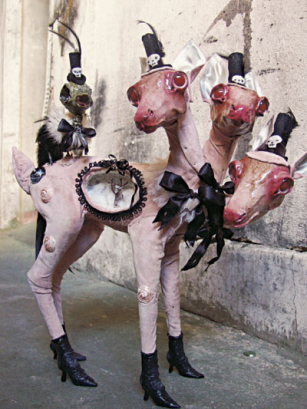| Umělec 2007/4 >> Low Brow de Los Angeles | Просмотр всех номеров | ||||||||||||
|
|||||||||||||
Low Brow de Los AngelesUmělec 2007/401.04.2007 Tony Ozuna | as seen on tv | en cs de es |
|||||||||||||
|
What should a group of artists do when they don’t like the name they’ve been identified with by dim and vicious art critics and the media? This is just one of the plights of Los Angeles artists tagged as “Low Brow,” in the documentary film “The Treasures of Long Gone John” by Gregg Gibbs. Gibbs’ movie describes the life of shaggy-haired, fun-loving, Long Gone John, an obsessive “low brow” art and toy collector, who is also the founder of one of the most prolific punk and garage rock labels of all time, Sympathy for the Music Industry, based in Long Beach, south of Los Angeles. Most of the “Low Brow” artists got their start doing blazing record or CD covers for Sympathy releases of bands like The Mumps, The Bloody Hollies, Banana Erectors, and Claw Hammer.
In the film there are L.A. artists like Camile Rose Garcia, Mark Ryden, Todd Schorr, Gary Baseman, Bad Otis Link, and Robert Williams, the grandfather of “Low Brow,” who are all well-represented in the home collection of Long Gone John. Though they don’t point this out with such detail, per say, their shared artistic influences include the psychedelic 60s (graphics and fashion), all- girl rock groups, classic American TV sitcoms or series’ from the 60s and 70s (such as The Munsters, Brady Bunch, Addams Family, The Monkees, Dark Shadows, and The Twilight Zone), the early days of the California punk rock scene with L.A. bands The Germs, X, Castration Squad, Fear, The Weirdos, and later the Circle Jerks and Black Flag, and from the San Francisco scene, the Dead Kennedys, and Flipper; from an earlier era, there is film noir, surf music (The Ventures or Dick Dale, not the Beach Boys), que-pee dolls and bobble-heads (not Barbies), Sci-fi (especially Phillip K. Dick), Alberto Vargas’s Playboy pin-up girls, soft-core horror and gore movies—especially the B-movies of Russ Meyer (Faster Pussycat, Kill Kill), and Hershell Gordon Lewis (The Gore-Gore Girls, aka Blood Orgy, or The Adventures of Lucky Pierre), Walt Disney and his magic kingdom— Disneyland, the beatniks and “cool” or Pacific (West Coast) jazz of the 50s and 60s, Japanese anime and artists who thrive on it like Yoshitomo Nara and Takashi Murakami, American comic books from the 50s and 60s (i.e. Robert Crumb), second-hand clothing, classic American cars from the 50s and 60s, especially Cadillacs, Thunder-Birds, all Chevys or Fords, and from the 70s, Pintos, Gremlins, and Dodge Darts; finally there would be Charles Bukowski, the flamboyant Melrose Avenue in West Hollywood (for toys, clothes and music), a garage and punk rock radio DJ (British-born with British-accent) in Los Angeles named Rodney Binginheimer, a sexy hostess in gothic lingerie for late-late night horror movies on Channel 9, named Elvira, and last but most importantly, perhaps the only European influence with the exception of Brigette Bardot, would be the surrealists. And so a surrealistic coagulation of iconic images from TV, the punk rock scene & flea market and thrift shops i.e. “lower” zones of American pop culture expressed on canvas or molded into extremely cool little plastic dolls is one way to explain “Low Brow.” Another option is to let the images speak for themselves, and to hell with any tag at all.
01.04.2007
Рекомендуемые статьи
|
|||||||||||||









Комментарии
Статья не была прокомментированаДобавить новый комментарий